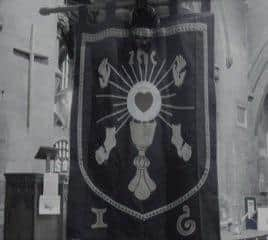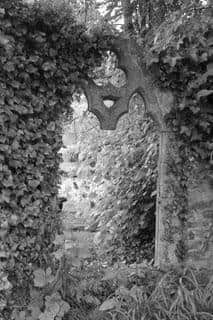‘The most brute and beastly shire’


His cast-off first wife, Katherine of Aragon, had died in the earlier months of the year; his second, Anne Boleyn, he had executed on trumped-up charges of adultery, incest and treason; and he had just married his third, Jane Seymour.
On top of this, there was trouble brewing in the north of the country and in Lincolnshire, an area which he would later describe as “the most brute and beastly shire”.
Advertisement
Advertisement
So what had our county done to deserve such harsh words from the much-married king?


This was the period in history called the Lincolnshire Rising, or the beginning of the Pilgrimage of Grace, which saw the market towns of Louth, Market Rasen, Horncastle and others join together to start a riot which would see thousands of people descend on London in protest at the way their places of worship were being destroyed.
We teamed up with historians from the Rase Heritage Society and author Nick Fox, who has written a book about this very subject, to find out more about the Lincolnshire Rising, and where the most significant events in the Wolds took place.
The origins of the Rising were in the changes that King Henry was making at that time to the way the church was organised and run in England.
Advertisement
Advertisement
These changes involved investigating the competence of the clergy and the confiscation of church property as a way to recoup funds that were running low due to the ending of Henry’s pension from France.


The King sent commissioners throughout the country to carry out this investigation and they were in Lincolnshire in 1536, resulting in the closure of Louth Park Abbey in September 1536, its property being taken by the King.
Some of the monks who were turned out of the abbey stayed in the area, some in Louth itself.
The abbey itself was dismantled completely, and some of its stones were used in the building of the nearby Priory Hotel by mathematician and architect Thomas Espin, with some of these stones still existing today in the rear of the building.
Advertisement
Advertisement
At that time, the people of Louth were very proud of their church, St James’. Just 20 years before, a beautiful new spire had been completed on the church – the tallest spire on a parish church in all England – and there were many fine church goods.


King Henry had renounced the Catholic faith, and had brought in the Act of Supremacy and the Treason Act, which the former announced Henry as Supreme Head of the Church of England and the latter to make it a treasonable offence for anyone to contradict this - or anything else the King said.
This obviously posed a problem for the clergy, as they had always seen the Pope as the head of the church, and the King’s Chancellor Thomas More and Bishop Fisher had been executed only two years before for refusing to accept Henry as Head of the Church of England and his marriage to Anne Boleyn.
The rebellion is believed to have been ignited by an inflammatory sermon given by William Kendell, the Vicar of Louth, who was warning the congregation of what as to come as the church would also be taken by the crown - although he would later claim that his words were merely a warning and not inciting a rebellion, as he had no further involvement in the Rising.
Advertisement
Advertisement
Nicholas Melton, a shoemaker in the town, then took the keys to the church, along with a couple of others, and decided to march to Lincoln and went via Caistor. The mob was more than 3,000 strong by the time they descended on the town.
Officials from the King’s office were surrounded by the mob at Caistor Hill, and some managed to escape on horses, including Lord Burgh - although his servant was not so lucky and he was beaten to death by the mob.
A former monk from Louth Park Abbey, William Moreland, was among the rebels and was said to be horrified at the treatment of the servant and is said to have heard the man’s last confession as he lay dying.
On October 4, Dr Raynes, the chancellor of the Bishop of Lincoln, who was staying nearby at Bolingbroke, was dragged from his sickbed and taken to Horncastle by the rebels.
Advertisement
Advertisement
It is then said that Dr Raynes was pulled off his horse and beaten to death with wooden poles - this is thought to have happened at The Wong in Horncastle opposite the police station, where there now stands a car park.
Thomas Wolsey, one of Thomas Cromwell’s men, was also captured and lynched by the mob that same day.
The Leach brothers, Nicholas and Robert from Fulletby, were also involved in the Rising, and went to Spilsby to recruit more men to the rebellion.
William Leach came to Horncastle and, along with another man, Philip Trotter, stole a suit of armour from St Mary’s Church in the town along with the Dymoke family banner, as Edward Dymoke, of Scrivelsby, was the Sheriff of Lincolnshire at the time.
Advertisement
Advertisement
The rebels made Dymoke a de facto leader of the rebellion and installed the family banner at the front of the crowd.
This is where the Dymoke banner was abandoned as the family wanted to appear favourable to the King and having their family sigil at the front of the rebellion wouldn’t have reflected well - a move which would later prove fortunate for the family as Sheriff Dymoke later joined the royal forces and escaped punishment for their part.
And so the iconic banner depicting the five wounds of Christ and the Holy Trinity was created instead.
This caused concern among the clergy in the Rising, as the religious icons made it very clear this was a war of religion and it was known that King Henry had no qualms executing members of the clergy, as Thomas More and Bishop Fisher’s fates had proven.
Advertisement
Advertisement
On October 5, the rebels arrived at Market Rasen where they were joined by the men from the town. The rebel host – estimated by some to be as many as 40,000 men – spent that night on Hambledon (now Hamilton) Hill near to Market Rasen, the gentry spending the night in the town.
The next day the rebels went on to Lincoln. They were told to wait in Lincoln to hear news about the King’s response to their petition to cease the seizing of Catholic churches and property - and also in an effort to keep them in one place to make the rounding up of “traitors” easier.
The King’s reply was that the rebels disperse and directed the gentry to take control and arrest the leaders of the rebellion and give them to the King’s lieutenant, who was with the King’s army which was on its way north from London.
By the middle of October, the King’s forces began to arrive in Lincoln and then proceeded to round up the rebels from Louth, Market Rasen and the other rebellious towns - those that remained at least, as many simply went home when they heard the Kings councillors were on the way.
Advertisement
Advertisement
One hundred men, 13 from Lincolnshire, were eventually tried for their part in the rebellion and executed at Tyburn by being hanged, drawn and quartered, William Kendell the Vicar of Louth being among them, as well as the monk William Moreland who was trying to calm down the violence at Caistor Hill, Philip Trotter and the Leach brothers.
Another 40 men from Louth, Horncastle and Market Rasen were taken home and executed.
One member of the gentry, Sir John Hussey from Sleaford, a former close friend of King Henry, was another who lost his life for his part in the rebellion.
Henry wanted to punish all of the implicated gentry from Lincolnshire, but this would have left a political void in the county so Henry decided to make an example of Hussey to show the other gentry what would happen to those who rebelled against the crown.
Advertisement
Advertisement
Lord Hussey’s lands and titles were stripped of him and he was beheaded.
What became of Nicholas Melton is unknown, however, as he is not listed among those executed at Tyburn - which you would think he would be as he was the instigator of the Rising.
Some believe he died under torture after his arrest.
William Leech from Fulletby somehow escaped punishment for his part in the Rising, but his luck ran out when he was arrested for killing a messenger of King James of Scotland in 1543 and hanged in York.
Today, there exists a blue plaque on the wall opposite St James church to pay tribute to the origin of this significant period of civil unrest in the country.
Advertisement
Advertisement
Ultimately, it was all in vain as Henry VIII’s religious overhaul continued long after the Lincolnshire Rising.
The king would later visit Lincoln Cathedral as part of his northern progress with his fifth wife, Katherine Howard, in 1541 and forgave the county for rising against him.
Today, we celebrate Lincolnshire Day on October 1 to pay tribute to the day our county stood up to Henry VIII.